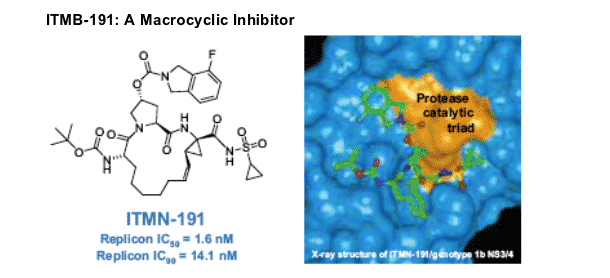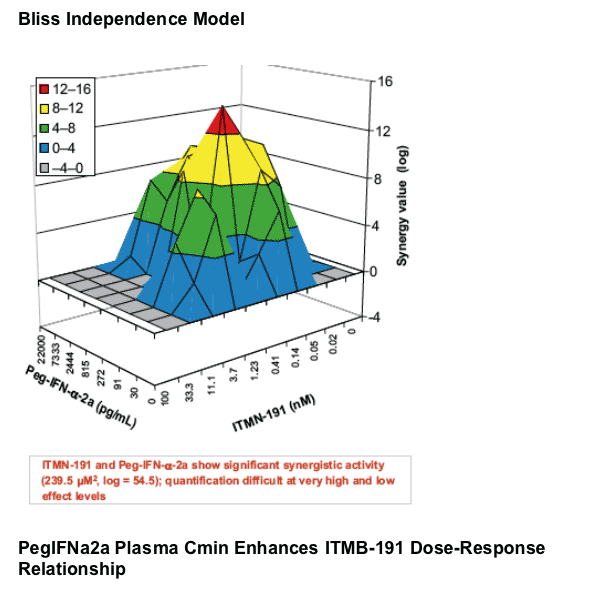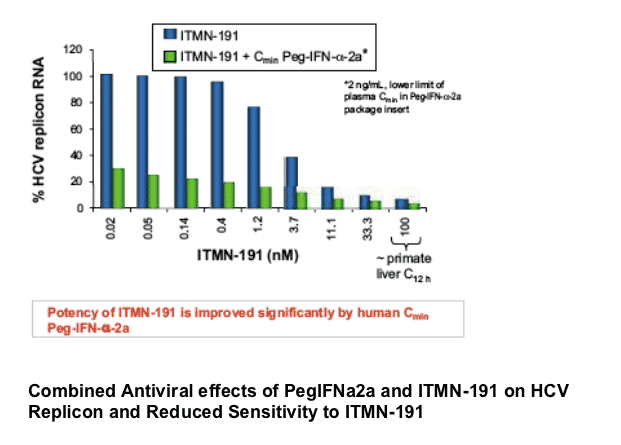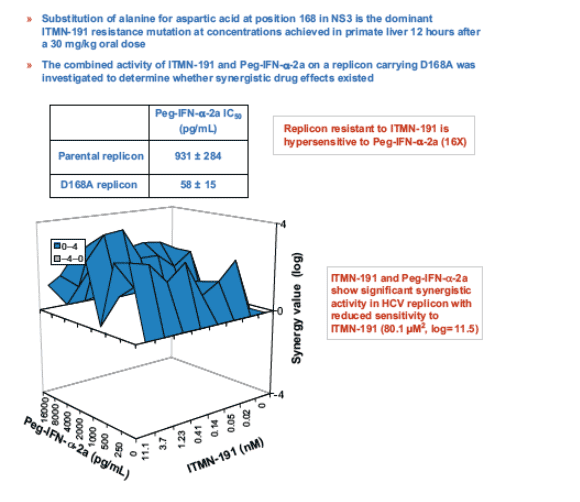 |
 |
 |
| |
In Vitro Synergistic Antiviral Activity of ITMN-191, an Orally Active Inhibitor of the Hepatitis C Virus (HCV) NS3/4A Protease, in Combination with PEG-Interferon Alfa-2a
|
| |
| |
Reported by Jules Levin
HUA TAN; SCOTT D. SEIWERT; LAWRENCE M. BLATT Research, InterMune, Inc., Brisbane, CA
Annual Meeting of the American Association for the Study of Liver Diseases, October 30, 2006, Boston, MA
ITMN-191 is a potent, orally active small-molecule inhibitor of NS3/4A
currently in clinical development.
It is anticipated that such protease inhibitors will be used in combination with Peg-IFN- at least initially.
Here, the combined antiviral effects of ITMN-191 and Peg-IFN- -2a were
Investigated.
The authors concluded:
ITMN-191 and Peg-IFN-a -2a (Pegasys) demonstrate potent antiviral synergy by multiple analyses.
When used in combination, reduced doses of both agents produce antiviral effects similar to higher doses of each agent when used individually.
At its minimal plasma concentration, Peg-IFN-a-2a greatly enhances the potency of ITMN-191.
Clinical exploration of the combined antiviral effects of these two agents is warranted.
ABSTRACT
Purpose: ITMN-191 is a highly potent, orally absorbed inhibitor of the NS3/4A protease, which accumulates in the liver of rats and cynomolgus monkeys at levels suggestive of human efficacy. This compound is currently undergoing preclinical development. The objective of this study was to evaluate the in vitro antiviral activity of ITMN-191 in combination with peginterferon alfa-2a (Peg-IFN-_-2a).
Methods: Two replicon systems were used for anti-HCV drug-drug interaction study: an HCV genotype-1b replicon (K2040) and a derivative of K2040 with reduced sensitivity to ITMN-191 (R191M320). Drug-drug interaction data were analyzed by the Loewe additivity model and the Bliss independence drug-interaction model.
Results:
The combination of ITMN-191 and Peg-IFN-_-2a inhibited HCV RNA
replication synergistically in Huh7 cells.
Analysis of fixed-dose ratios by the Loewe additivity model showed that combination of the two drugs yielded combination index (CI) values indicative of synergy at EC50, EC75 and EC90 (0.3, 0.4, and 0.4, respectively), and isobologram analysis supported synergistic interaction.
The drug reduction index (DRI) values were >1, suggesting a potential clinical benefit when ITMN-191 is administered in combination with Peg-IFN-_-2a.
Analysis of variable ratio drug combinations by the Bliss independence model indicated that the synergy volumes observed in ITMN-191 combinations were significant (>50 _m2). Peak synergy volumes occurred at low concentrations, all of which may be therapeutically relevant.
The extent of synergy observed by either method is quantitatively larger than that observed for the experimental HCV protease inhibitors VX-950 and SCH 503034.
Importantly, the human minimum plasma concentration (Cmin) of Peg-IFN-_-2a greatly improved ITMN-191 potency in a replicon fully sensitive to ITMN-191 and in a replicon with reduced sensitivity to ITMN-191. Additionally, the replicon with reduced sensitivity to ITMN-191 was hypersensitive to Peg-IFN-_-2a relative to the parental replicon (>10-fold).
Conclusions: These data suggest synergistic antiviral activity of the combination of ITMN-191 and Peg-IFN-_-2a in vitro. Future clinical study is warranted to address whether the combination will yield a greater virologic response in HCV patients than either ITMN-191 or Peg-IFN-_-2a alone.

Experiment design and Analysis of Synergy
Two experimental strategies were used to investigate antiviral synergy.
For both strategies, an ELISA-based readout for expression of a selectable marker carried by the HCV replicon was used to monitor HCV replicon levels (NPTII protein).
Loewe Additivity Model:
>> The dose-effect curves for each drug were converted to median-effect plots
>> Triplicate data sets were examined
>> Isobolograms graphically represent additive, synergistic and antagonistic drug effects. In this representation, an IC value of one drug is plotted on one axis and the corresponding IC value of a second drug is plotted on a second axis; the line connecting these two points represents the amount of each drug in a combination that would be required to reach the equivalent IC value provided their effects are additive. Synergistic action is indicated if lower doses of either agent can support an identical IC value; i.e. points fall below the line of additivity.
>> Drug Reduction Index (DRI) and Combination Index (CI) were calculated to quantify interdependence of antiviral effects
- DRI quantifies the factor by which the dose of each drug in a combination may be reduced at a given effect level compared with the dose when each drug is used alone. DRI is calculated from the median effect equation taking into account potency (median effect) and the shape (sigmoidicity) of the dose effect curve. A DRI is associated with each drug in a combination.
- CI takes into account the DRI of each agent: CI = 1/(DRI)drug 1 + 1/(DRI)drug 2
- Synergy, CI = 1 - 0.3
- Strong synergy, CI = 0.1 - 0.3
>> Analysis performed in Calcusyn
Bliss Independence Model
>> Non-parametric three-dimensional approach to quantify areas where observed effects are significantly greater (synergy) or less (antagonism) than those predicted from single-drug control data
>> Dose-response curves are generated using a checkerboard design in which drug ratios and concentrations were both varied
>> Analysis performed in MacSynergy II
>> Triplicate data sets assessed at the 95% confidence level:
- Minor synergy = values >25 to <50 _M2
- Moderate synergy = values >50 to <100 _M2 (log volumes >5 and <9)
- Strong synergy = values >100 _M2 (log volume >9)



|
| |
|
 |
 |
|
|